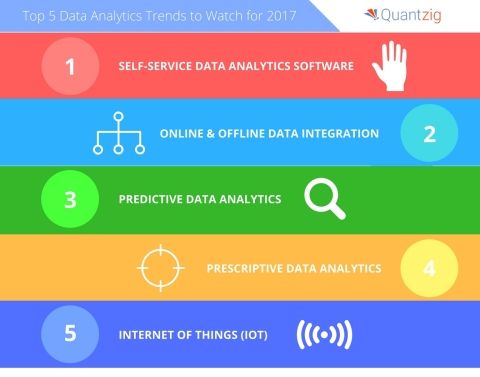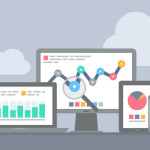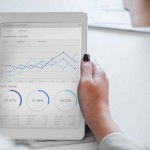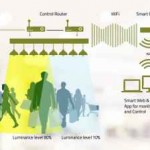Top 5 Data Analytics Trends for 2017

According to global analytics and advisory firm Quantzig, as of 2015, analytics platforms and advanced analytics accounted for nearly 25% of the overall global business intelligence market. The transformation from business intelligence to advanced analytics techniques is leading to rapid growth of the market, in fact, between 2017 and 2020, the advanced analytics market will nearly double in size. This is one of many trends that will build off a strong 2016 and will continue to shape the industry this year.
Top Data Analytics Trends for 2017
1) Self-service data analytics
Self-service data analytics software means that you do not have to be an experienced data analyst to analyze data related to your business. Vendors pushed for software that is user-friendly, and now they have it. In 2017, we will see more small businesses opt for self-service data analytics software to access and analyze data so that they can react to customer patterns in near-real time.
2) Online and offline data integration
Online and offline data integration is used to combine the data from a business in one place. This means data from the cloud and on-premises as well as legacy systems can be merged to give business owners a single view of their circumstances. This single view allows owners to make better decisions about how to promote and run their companies.
3) Predictive data analytics
Predictive data analytics allow business owners to predict what their customers will need in the future, rather than assume that what has worked in the past will continue to work in the future. This market is expected to grow at a CAGR of 25% between 2015-2020, according to Quantzig.
4) Prescriptive data analytics
Prescriptive data analytics take predictive data analytics one step further: it analyzes different decisions the user could make in terms of the outcome and how that outcome relates to the user’s goal. This allows the user to adjust their plan before putting it into effect, potentially saving time, money, and embarrassment. Some experts predict nearly 40% of businesses will use prescriptive data analytics by 2020.
5) The Internet of Things (IoT)
IoT provides enormous amounts of data. As consumers become more and more connected, we will see more reliance upon IoT data. Businesses can use this data to customize their dealings with each and every customer.

Kalyan Banga226 Posts
I am Kalyan Banga, a Post Graduate in Business Analytics from Indian Institute of Management (IIM) Calcutta, a premier management institute, ranked best B-School in Asia in FT Masters management global rankings. I have spent 14 years in field of Research & Analytics.











2 Comments
How User Data is Revolutionizing the Enterprise? - Fusion Analytics World
April 2, 2017 at 2:06 am[…] organizations, the basic aim of data analytics is to convert the large amount of information they receive on a daily business into customer or […]
Blueocean MI and Cross-Tab Merge to Form Course5 - Fusion Analytics World
June 7, 2018 at 3:35 pm[…] combines the deep expertise and resources of both companies across data analytics, artificial intelligence, and market research domains, to create huge synergies for innovation and […]